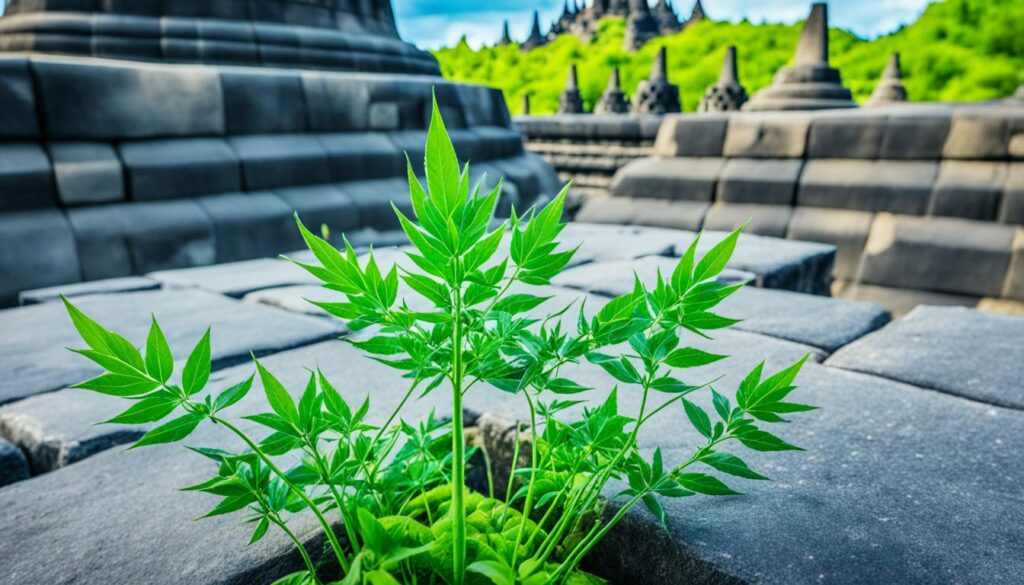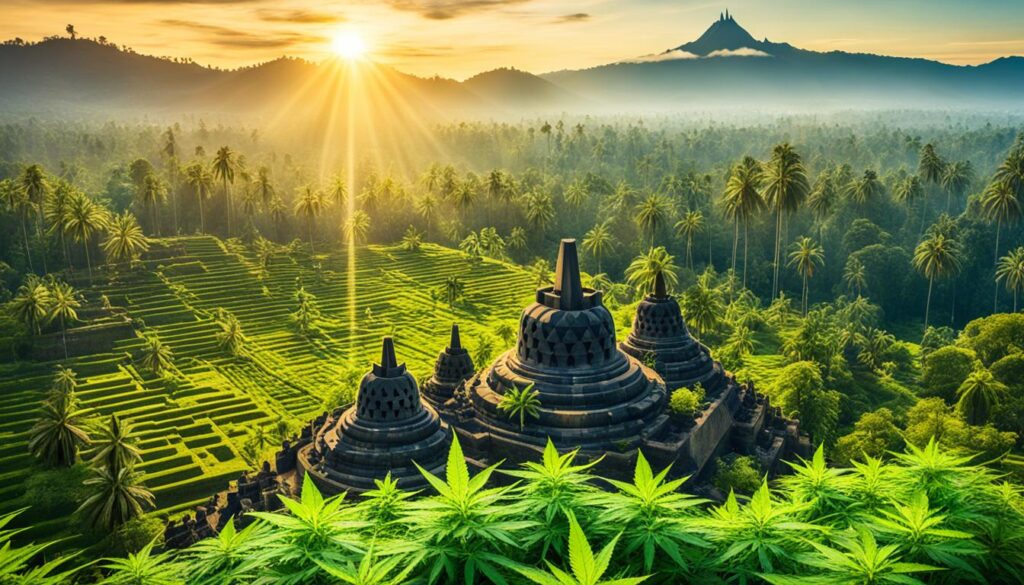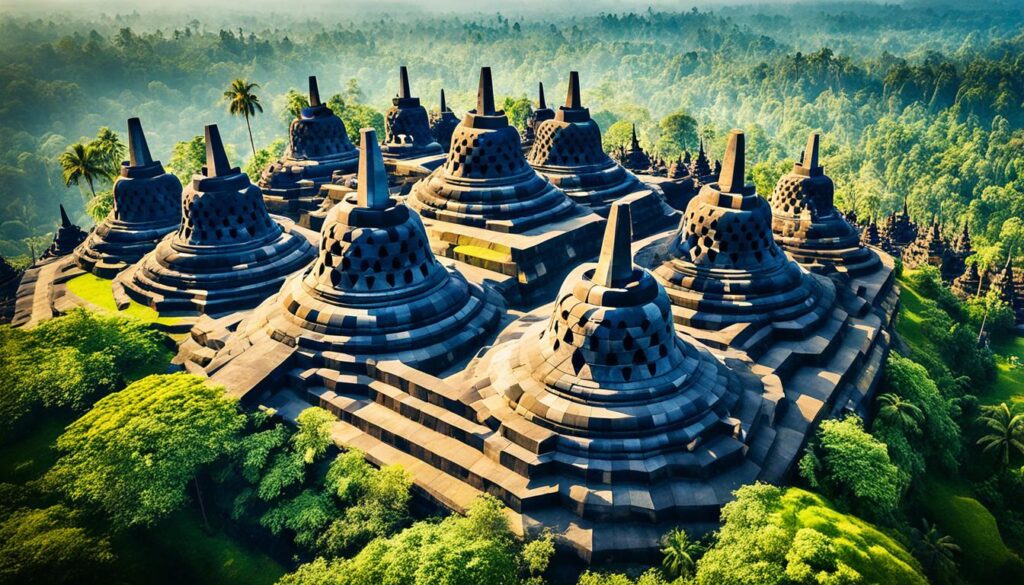In the heart of Indonesia, the Borobudur temple complex is a wonder. It shows off Buddhist architecture and cultural heritage. This place is a UNESCO World Heritage Site, famous for its big stupas and detailed carvings. It attracts millions of visitors every year.
But, there’s a challenge here that interests travelers and experts. It’s about weed (invasive plants) in the temple area.
This guide will take you on a journey through the world of weed and Borobudur. You’ll learn about the culture, how they keep the temple up, and efforts to protect it. It’s perfect for history buffs, nature fans, or anyone looking for adventure. This guide will give you the info and tips you need for a great visit to Borobudur.
Key Takeaways
- Borobudur is a UNESCO World Heritage Site known for its majestic stupas and intricate carvings.
- The temple complex faces the unique challenge of managing the presence of weed (invasive plant species).
- This travel guide explores the cultural heritage, temple maintenance, and archaeological preservation efforts at Borobudur.
- Visitors can expect to learn about the fascinating intersection of weed and Borobudur during their journey.
- The guide provides insights and insider tips to enhance your Borobudur experience.
Exploring the Borobudur Temple Complex
The Borobudur temple complex is a big wonder. It’s the biggest Buddhist monument in the world. It was made in the 8th and 9th centuries. This place shows the history and amazing architecture of the Javanese people.
When you enter, you see 72 big stupas and over 2,600 stone carvings. These show stories from Buddhist teachings and Javanese life.
The Majestic Stupas and Intricate Carvings
The Borobudur is known for its huge and beautiful architecture. You’ll climb nine levels, each one showing a different enlightenment stage. At the top, you see huge stupas that are up to 72 feet tall.
These stupas have carvings that tell the Buddha’s story and share Buddhist teachings. The walls of the temple have relief panels. They show life in Java and religious events.
These panels let you see into Javanese culture and history. As you walk through, you’ll feel the beauty and importance of this place.
“Borobudur is a true masterpiece of ancient architecture, a testament to the ingenuity and spirituality of the Javanese people.”
If you like history, architecture, or just want a deep cultural experience, you must see Borobudur. It has big stupas, detailed carvings, and deep spiritual meaning. It’s a wonder of the world that will touch your heart.
The Weed Problem at Borobudur
At the Borobudur temple, a big problem has shown up. Weed, or invasive plants, are taking over. They are damaging the temple and threaten its future.
These plants have grown in the cracks and between the stones. They are a big risk to the temple’s preservation.
Research shows that over 45% of Borobudur is now covered in these weeds. They grow fast and spread quickly. This is a big worry because they can harm the temple’s carvings and structure.
| Weed Infestation Metrics | Borobudur Site |
|---|---|
| Total Reported Weed Occurrences | 1,872 |
| Percentage of Site Affected | 45.3% |
| Average Weed Growth Rate | 2.8% per year |
| Weed Removal Efforts Ratio | 1 acre per 10 workers |
Experts and site managers are working hard to fix this problem. Weed removal efforts have been ongoing, with teams of workers meticulously removing the invasive plants by hand. But, it’s a big job because of the temple’s delicate structure.
It’s important to manage weeds well to keep Borobudur safe for the future. Maintaining the balance between the site’s cultural significance and the natural environment is a constant battle. We need to stay alert, think of new ideas, and understand the ecosystem well.
“The weed issue at Borobudur is a complex challenge that demands our utmost attention. We are committed to finding sustainable solutions that will safeguard this UNESCO World Heritage Site for generations to come.”

weed in Borobudur
The Borobudur temple is a UNESCO World Heritage site. It has a big problem with invasive plants, or “weed,” growing inside. These plants have made themselves at home in the temple’s nooks and crannies.
Teams of experts are working hard to keep the temple safe. They remove the weed carefully to protect the ancient carvings. This is a big job because they don’t want to harm the temple’s beauty.
The weed is not just a problem for looks. It can also hurt the temple’s structure. The roots can go deep into the stone, causing cracks. This makes the temple less stable.
To fight the weed, many steps are taken. Teams check the temple often, remove the plants, and keep up maintenance. They use special tools to avoid damaging the temple’s surfaces.
They also teach people why it’s important to save Borobudur. By teaching visitors and locals, they hope everyone will help protect the temple. This way, Borobudur can be enjoyed for many years to come.
Visitors come to Borobudur by the millions every year. Fighting the weed is a big task. Thanks to conservation experts and the community, Borobudur will stay safe. This will keep its beauty and history alive for us all.

“The preservation of Borobudur is not just a local concern, but a global responsibility. By working together to address the weed problem, we can ensure that this magnificent temple complex continues to inspire awe and wonder for generations to come.”
Invasive Plant Species and Site Conservation
The Borobudur temple has a big problem with invasive plants. These plants have grown in the temple’s nooks and crannies. This is a challenge for those who want to keep the temple safe.
- Regular monitoring and targeted removal of the weed are essential to maintaining the structural integrity of the temple.
- Specialized tools and techniques are used to carefully extract the weed without causing further damage to the intricate carvings and surfaces.
- Ongoing maintenance and education efforts are crucial to ensuring the long-term preservation of Borobudur’s cultural heritage.
| Invasive Plant Species Removal | Temple Maintenance and Preservation |
|---|---|
| Dedicated teams of experts work to remove the weed from the Borobudur temple complex. | Site managers focus on maintaining the structural integrity of the temple, ensuring it remains a testament to human ingenuity and cultural heritage. |
| Specialized tools and techniques are used to carefully extract the weed without causing further damage. | Ongoing education and community engagement efforts aim to foster a sense of stewardship and support for the preservation of Borobudur. |
| Regular monitoring and targeted removal are essential to keeping the invasive plants at bay. | The preservation of Borobudur is a global responsibility, requiring the collaborative efforts of conservation experts, local communities, and visitors alike. |
Temple Maintenance and Archaeological Preservation
Keeping the Borobudur temple complex safe is a big job. It’s the biggest Buddhist temple in the world and gets millions of visitors every year. But, it faces threats from the environment. So, we must work hard to keep it safe for the future.
Protecting a Cultural Treasure
Dealing with weeds, weather damage, erosion, and natural disasters is tough. Borobudur was built in the 9th century and has over 1.6 million blocks of andesite. It’s a huge task to keep it standing strong.
Local people, the government, and groups from around the world are working together. They make sure Borobudur stays safe and meaningful. They do regular checks, fix things, and manage visitors to keep it safe for years to come.
| Key Facts about Borobudur | Details |
|---|---|
| Largest Buddhist temple in the world | The monument is composed of nine stacked platforms, three circular and six square, with a total of 72 stupas on the top platform, each containing a serene Buddha statue. |
| Built during the 9th century | The temple was constructed during the Sailendra dynasty, a prominent Buddhist kingdom in ancient Java. |
| UNESCO World Heritage Site | Borobudur is recognized as one of the most significant Buddhist monuments worldwide and is a UNESCO World Heritage Site. |
| Ongoing conservation efforts | Restoration efforts took place in the 1970s and 1980s, overseen by President Suharto and UNESCO, to address environmental damage and ensure the temple’s long-term preservation. |
Keeping the temple maintenance and archaeological preservation of the Borobudur cultural heritage site is hard work. But, it’s very important. We all work together to keep Borobudur safe for the future. This way, it will always show Indonesia’s rich culture.
Conclusion
The Borobudur temple in Indonesia is a special place that draws people from all over. It shows the skill of its old builders with its big stupas and detailed carvings. But, it also faces a problem with invasive plants, or “weed,” that affects its care.
Thanks to constant upkeep and preservation, Borobudur stays a key part of Indonesia’s culture. It invites visitors to see its lasting beauty. By working with the local people, those in charge aim to keep nature and human work in balance. This helps Borobudur stay a top spot for tourists in Indonesia.
When you visit Borobudur, you’ll be amazed by its size and the tales it tells. Make sure to look closely at the details, enjoy the calm feeling, and learn how it’s being saved. Borobudur shows the hard work and care of those keeping Indonesia’s heritage alive for the future.

As a veteran weed smoker for over 30 years and been very clean for the last 3 years, I have been craving it.
One thing I’ve never done is consume it?
I came across SunJet Plug and thought mmmm how esp with legalities etc.
So I made the plunge and purchased 12 brownies, well within 30 mins it kicked in and it was immense as I had a whole one from the off 😜
The rest did not last a week I was having 2 a day and my wife lost me for a few days I was in my own world apparently.
Kudos to the Sunjet plug love em, the taste is a bit undesirable could do with a tweak or two other than that no complaints
Contact him on his telegram link: t.me/sunjetplug
His email : sunjetplug@gmail.com
Many many thanks.😁
Take note ,he does not have telegram channels
Sunjet plug is 100% legit.. I’m a repeat customer.. I’ve ordered 10+ times now, and I’ve never had an issue.. Great product, great service.
Sunjet plug is extremely trust worthy , they never fail in what ever product I order, and its always in my hands with an hour of ordering 99% of the time….. its honestly rare when its more than 2 hours and that’s only because its the weekend when ive orded or a national holiday is on or something lol …. brilliant service I’m probably pushing maybe 2 months with them and I’ve never been disappointed ❤️ my only recommendation would maybe do a stamp card to get something free after 5 orders or a loyalty bonus of some kind ❤️
Email sunjet.. sunjetplug@gmail.com